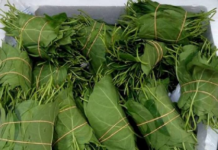Recent studies have shown that high consumption of fruits and vegetables may delay the process of degenerative diseases in humans.
Degenerative diseases are diseases that cause the structure or function of affected parts of the body to increasingly deteriorate over time, whether due to normal bodily wear or lifestyle choices. They include cancer, diabetes, heart disease, osteoarthritis, osteoporosis, Alzheimer’s disease, Parkinson’s disease, and so on.
In a research conducted by scientists from the Department of Pharmacognosy, Faculty of Pharmacy, University of Lagos, Nigeria, and Department of Pharmacognosy, Faculty of Pharmaceutical Sciences, University of Nigeria, Nsukka, Nigeria, it was stated that high consumption of vegetables containing phenolic antioxidants may slow down the process of degenerative diseases.
Titled, “Antioxidant activity of selected Nigerian green leafy vegetables”, the study which was published in the American Journal of Food Technology 2 (3), and compiled by O.A Odukoya; S.L Inya-Agha; F.L Segun; M.O. Sofidiya; and O.O.Ilori recommends more consumption of vegetables because of their potential health benefits.
In conducting the study, the researchers experimented on the hot water extracts of 21 locally purchased green leafy vegetables. The vegetables include: Amaranthushybridus Linn. (Arnaranthaceae), Amaranthuscaudatus (Arnaranthaceae), Beilschmediamanni (Meisn.)Benth. Et Hook.f. (Lauraceae), Celosia argenteavarargentea (L.) 0. Knntze (Arnarantheceae) Celosia argenteavarcristata Linn. (Arnarantheceae), Corchorusolitorius L. (Tiliaceae), Crassocephalumcrepidioides (Benth).S.Moore (Asteraceae).
Othersr are: GnetumbucholzianumWelw.(Gnetaceae), GongronemalatifoliumBenth.(Asclepiadaceae), Heinsiacrinita (Afz.) G. Taylor (Rubiaceae), Hibiscus callyphyllus Cav. (Malvaceae),Lasiantheraafricana P. Beauv (Icacinaceae),Myrianthusarboreus P. Beauv. (Urt:icaceae ),Pterocarpusmildbraedii Harms (Papilionaceae ),Pterocarpussantalinoides DC. (Papilionaceae), Solanummacrocarpon L. (Solanaceae), Solamtmmelongena Linn.(Solanaceae), Struchiumsparganophora (Linn.) 0. Ktze (Asteraceae), Talinumtriangulare (Jacq.)Wild.Portulacaceae, Telferiaoccidetalis Hook (Curcurbitaceae) and Vernoniaamygdalina Del. (Asteraceae).
Preparation of materials
The vegetables were picked to remove debris, cut into small pieces and air dried. The materials were weighed (20 g) and homogenised with (100 mL) of distilled water using a Moulinex blender. Thereafter, the vegetables were tested to determine the antioxidant activity, total phenolic content and ascorbic acid content, through different methodologies.
Study procedure
The study observed that the protective action of fruits and vegetables is attributed to the presence of anti-oxidants, especially anti-oxidant vitamins, including ascorbic acid, a-tocopherol and P-carotene. It also noted that some vegetables need to be cooked before they become edible.
All the samples studied are eaten as cooked leafy vegetable in soups, while three species (Gnetumbucholzianum, G. africanum and Gongronemalatifolium) are also eaten raw in salads.
The study further stipulates cooking vegetables with minimal heat, since it is well established that many vitamins like vitamin C are easily destroyed by heat and light.
“Many studies have revealed that beta-carotene and antioxidant phenolic compounds are actually more bio-available from cooked vegetables compared with raw. This is probably due to cooking breaking down the tough cell walls, releasing the nutrient content for easier absorption from the small intestine,” the study said.
Carotenoids are present in chloroplasts in the leaves of dark green leafy vegetables, which are not readily digested in the body. It is believed that the fibre of vegetables entraps the beta-carotene, reducing its availability to be incorporated into micelles prior to absorption from the intestines. In contrast, beta-carotene in fruits is contained within the readily digestible cell wall. Hence, cooking of vegetables before eating increases bioavailability.
Antioxidant activity was accessed as a marker of lipid peroxidation in linoleic acid model. Thus, the study showed that there are large differences among total antioxidants in various dietary vegetables. The researchers noted that the correlation of variation in antioxidant activity of the vegetables may be due to the differences in the structures of phenolic compounds primarily related to their hydroxylation and methylation patterns and increased lag time of binding vegetable phenols with lipoproteins which subsequently protects them from oxidation.
“The human body cannot produce ascorbic acid, so it must be obtained entirely through one’s diet. The amount of ascorbic acid in the vegetables studied varied greatly. This might be as a result of factors as the variety, weather, maturity stage and storage. Since vitamin C is easily oxidized, storage and the cooking in air leads to the eventual oxidation of vitamin C by oxygen in the atmosphere.”
Related study
Researchers at the University College London (UCL) have also joined their voices to the campaign for increased consumption of fruits and vegetables, following a recent study by the institution which affirms that consumption of fruits and vegetables lowers mortality.
The researchers used the Health Survey for England to study the eating habits of 65,226 people representative of the English population between 2001 and 2013, and found that the more fruits and vegetables they ate, the less likely they were to die at any age.
Published in the Journal of Epidemiology & Community Health in April, the study found that eating seven or more portions of fruits and vegetables a day reduces risk of death at any point in time by 42 per cent, compared to eating less than one portion.
The study further found that vegetables had the strongest protective effect, with each daily portion reducing overall risk of death by 16 per cent. Salad contributed to a 13 per cent risk reduction per portion, and each portion of fresh fruit was associated with a smaller but still significant four per cent reduction.
Compared to eating less than one portion of fruit and vegetables, the risk of death by any cause is reduced by 14 per cent by eating one to three portions, 29 per cent for three to five portions, 36 per cent for five to seven portions and 42 per cent for seven or more. These figures are adjusted for sex, age, cigarette smoking, social class, Body Mass Index, education, physical activity and alcohol intake, and exclude deaths within a year of the food survey, the study explained.
The study was the first to link fruit and vegetable consumption with all-cause, cancer and heart disease deaths in a nationally-representative population, the first to quantify health benefits per-portion, and the first to identify the types of fruit and vegetable with the most benefit.
According to Dr Oyinlola Oyebode, lead author of the study, “We all know that eating fruit and vegetables is healthy, but the size of the effect is staggering. The clear message here is that the more fruit and vegetables you eat, the less likely you are to die at any age.
“Vegetables have a larger effect than fruit, but fruit still makes a real difference. If you’re happy to snack on carrots or other vegetables, then that is a great choice but if you fancy something sweeter, a banana or any fruit will also do you good.
“Whatever your starting point, it is always worth eating more fruit and vegetables. In our study, even those eating one to three portions had a significantly lower risk than those eating less than one.”
Additionally, the researchers found no evidence of significant benefit from fruit juice, while canned and frozen fruits appeared to increase risk of death by 17 per cent. The survey did not distinguish between canned and frozen fruits, so this finding is difficult to interpret
“Most canned fruit contains high sugar levels and cheaper varieties are packed in syrup rather than fruit juice. The negative health impacts of the sugar may well outweigh any benefits. Another possibility is that there are confounding factors that we could not account for, such as poor access to fresh groceries among people who have pre-existing health conditions, hectic lifestyles or who live in deprived areas”, Oyebode said.
References: Journal of Epidemiology & Community Health, UCL Epidemiology & Public Health, American Journal of Food Technology 2 (3): 169-175, 2007, ISSN 1557-4571












india pharmacy: https://genericwdp.com/ medications without a doctor’s prescription
what is tadalafil: http://tadalafilonline20.com/ tadalafil pills